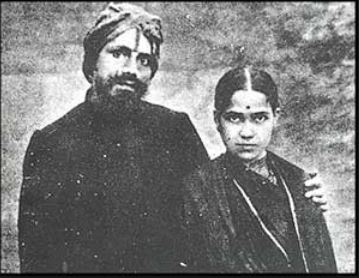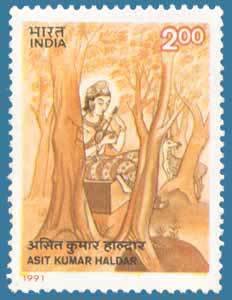|
Bhagini Nivedita
Sister Nivedita ( born Margaret Elizabeth Noble; 28 October 1867 – 13 October 1911) was an Irish teacher, author, social activist, school founder and disciple of Swami Vivekananda. She spent her childhood and early youth in Ireland. She was engaged to marry a Welsh youth, but he died soon after their engagement. Sister Nivedita met Swami Vivekananda in 1895 in London and travelled to Calcutta (present-day Kolkata), India in 1898. Swami Vivekananda gave her the name ''Nivedita'' (meaning "Dedicated to God") when he initiated her into the vow of ''Brahmacharya'' on 25 March 1898. In November 1898, she opened a girls' school in the Bagbazar area of North Calcutta. She wanted to educate girls who were deprived of even basic education. During the plague epidemic in Calcutta in 1899, Nivedita nursed and took care of the poor patients. Nivedita had close associations with the newly established Ramakrishna Mission. Because of her active contribution in the field of Indian National ... [...More Info...] [...Related Items...] OR: [Wikipedia] [Google] [Baidu] |
India
India, officially the Republic of India (Hindi: ), is a country in South Asia. It is the seventh-largest country by area, the second-most populous country, and the most populous democracy in the world. Bounded by the Indian Ocean on the south, the Arabian Sea on the southwest, and the Bay of Bengal on the southeast, it shares land borders with Pakistan to the west; China, Nepal, and Bhutan to the north; and Bangladesh and Myanmar to the east. In the Indian Ocean, India is in the vicinity of Sri Lanka and the Maldives; its Andaman and Nicobar Islands share a maritime border with Thailand, Myanmar, and Indonesia. Modern humans arrived on the Indian subcontinent from Africa no later than 55,000 years ago., "Y-Chromosome and Mt-DNA data support the colonization of South Asia by modern humans originating in Africa. ... Coalescence dates for most non-European populations average to between 73–55 ka.", "Modern human beings—''Homo sapiens''—originated in Africa. Then, int ... [...More Info...] [...Related Items...] OR: [Wikipedia] [Google] [Baidu] |
Friedrich Fröbel
Friedrich Wilhelm August Fröbel or Froebel (; 21 April 1782 – 21 June 1852) was a German pedagogue, a student of Johann Heinrich Pestalozzi, who laid the foundation for modern education based on the recognition that children have unique needs and capabilities. He created the concept of the ''kindergarten'' and coined the word, which soon entered the English language as well. He also developed the educational toys known as Froebel gifts. Biography Friedrich Fröbel was born at Oberweißbach in the Principality of Schwarzburg-Rudolstadt in Thuringia. A cousin of his was the mother of Henriette Schrader-Breymann, and Henriette became a student of his. Fröbel's father, Johann Jacob Fröbel, who died in 1802, was the pastor of the orthodox Lutheran (alt-lutherisch) parish there. Fröbel's mother's name was Jacobine Eleonore Friederike (born Hoffmann). The church and Lutheran Christian faith were pillars in Fröbel's own early education. Oberweißbach was a wealthy village in th ... [...More Info...] [...Related Items...] OR: [Wikipedia] [Google] [Baidu] |
The Master As I Saw Him
''The Master as I Saw Him: Being pages of the life of the Swami Vivekananda'' is a 1910 book written by Sister Nivedita. The book covers Nivedita's experiences with Swami Vivekananda, whom she met in London London is the capital and largest city of England and the United Kingdom, with a population of just under 9 million. It stands on the River Thames in south-east England at the head of a estuary down to the North Sea, and has been a majo ... during November 1895. The book was simultaneously published from England and India, and ''The Master as I Saw Him'' is now considered to be a classic text. In his book ''Indian Traffic'', Parama Roy noted that the book differed from other biographies of Vivekananda in that it " ouchedupon the agonistic, conflictual nature of the guru-disciple relationship" and showed "reticence about his corporeality". References External links Full book at Archive.org Indian biographies 1910 non-fiction books English-language books Bo ... [...More Info...] [...Related Items...] OR: [Wikipedia] [Google] [Baidu] |
An Indian Study Of Love And Death
''An Indian Study of Love and Death'' (1908) is a book written by Sister Nivedita. Background Nivedita travelled to India in 1898. Josephine MacLeod, a friend and devotee of Swami Vivekananda Swami Vivekananda (; ; 12 January 1863 – 4 July 1902), born Narendranath Datta (), was an Indian Hindu monk, philosopher, author, religious teacher, and the chief disciple of the Indian mystic Ramakrishna. He was a key figure in the intro ... asked him how best she could help him and got the reply to "Love India". Nivedita wrote multiple books on Indian history, culture, tradition etc. This book ''An Indian Study of Love and Death'' was one of those books. The author has divided the book in several chapters. In the first few chapters she has meditated (section "Meditation") on "The soul", "The love", "Inner perfection, "Peace", "Inner perfection". Later the book deals with the communion of the soul with the beloved. And finally it discusses on some rites Hindus observe to honour a ... [...More Info...] [...Related Items...] OR: [Wikipedia] [Google] [Baidu] |
Cradle Tales Of Hinduism
''Cradle Tales of Hinduism'' (1907) is a collection of stories by Sister Nivedita. It is an introduction to Hindu mythology; the stories come from the Mahabharata, the Ramayana and other Hindu sources and are presented as they were told in Indian nurseries. Background Nivedita travelled to India in 1898. Josephine MacLeod, a friend and devotee of Swami Vivekananda asked him how best she could help him and got the reply to "Love India". Nivedita wanted to interpret Indian culture to the Western world and so wrote this book. Stories Stories include– * Story of Shiva * Story of (Brahma) * Story of Rama * Story of the great snake * Story of Prahlada * Story of Dhruva etc. * Story of Sati * Story of Nala and Damayanti * Throne of Vikramaditya Vikramaditya (IAST: ') was a legendary king who has been featured in hundreds of traditional stories including those in ''Baital Pachisi'' and ''Singhasan Battisi''. Many describe him as ruler with his capital at Ujjain (Pataliputra or ... [...More Info...] [...Related Items...] OR: [Wikipedia] [Google] [Baidu] |
The Web Of Indian Life
''The Web of Indian Life'' (1904) is a book written by Sister Nivedita. This book is a collection of essays and created a sensation when it was first published. The introduction of the book was written by Rabindranath Tagore Rabindranath Tagore (; bn, রবীন্দ্রনাথ ঠাকুর; 7 May 1861 – 7 August 1941) was a Bengali polymath who worked as a poet, writer, playwright, composer, philosopher, social reformer and painter. He resh .... Theme In these essays of the book, Nivedita discussed on several topics of India, lives of Indians and Hindu people. She also discussed some of the aspects of Indian life such as the caste system, the role and position of women in society, the Indian (Vedic) concept of birth and death, Indian pilgrimages, the invasion of Islam in India, etc. References External links Full text at Sacred TextsFull book at archive.org {{DEFAULTSORT:Web of Indian Life Indian non-fiction books 1904 non-fiction books E ... [...More Info...] [...Related Items...] OR: [Wikipedia] [Google] [Baidu] |
Kali The Mother (book)
''Kali the Mother'' (1900) is an English book written by Sister Nivedita. Kali is a popular Hindu Hindus (; ) are people who religiously adhere to Hinduism.Jeffery D. Long (2007), A Vision for Hinduism, IB Tauris, , pages 35–37 Historically, the term has also been used as a geographical, cultural, and later religious identifier for ... goddess who is considered to free her worshippers from fear (anxiety) and all troubles. In this book Nivedita celebrated this Indian goddess Kali. Chapters * Title Page * Contents * Concerning Symbols * The Vision of Siva * Two Saints of Kali * The Voice of the Mother * A Visit to Dukineshwar * An Intercession * The Story of Kali for a Western Baby * Kali the Mother * Works by the Swâmi Vivekânanda References External links * Full text available at Sacred Text {{Authority control 1900 non-fiction books 19th-century Indian books English-language books Books by Sister Nivedita 20th-century Indian books ... [...More Info...] [...Related Items...] OR: [Wikipedia] [Google] [Baidu] |
Subramania Bharati
C. Subramania Bharathi Birth name: C. Subramaniyan, the person's given name: Subramaniyan, father's given name: Chinnaswami. (C. Subramaniyan by the prevalent patronymic initials as prefix naming system in Tamil Nadu and it is Subramaniyan Chinnaswami by the patronymic suffix naming system.) Bharathi is a conferred title meaning blessed by the goddess of learning. His name became C. Subramania Bharathi and he is also widely known mononymously as Bharathi. (In this article, the subject is referred using his title Bharathi because subject is not known without his title. (Permitted in WP per Wikipedia:Naming conventions (Indic)#Titles and honorifics)) (IPA: ; born C. Subramaniyan 11 December 1882 – 11 September 1921) was a Tamil writer, poet, journalist, Indian independence activist, social reformer and polyglot. He was bestowed the title "Bharathi" for his excellence in poetry. He was a pioneer of modern Tamil poetry and is considered one of the greatest Tamil literary figure ... [...More Info...] [...Related Items...] OR: [Wikipedia] [Google] [Baidu] |
Asit Kumar Haldar
Asit Kumar Haldar (10 September 1890 – 13 February 1964) was an Indian painter of Bengal school and an assistant of Rabindranath Tagore at Shantiniketan. He was one of the major artists of the Bengal renaissance. Early life Haldar was born in Jorasanko in 1890. His maternal grandmother was the sister of Rabindranath Tagore, making him Tagore's grandnephew. Both his grandfather Rakhaldas Haldar and his father Sukumar Haldar were accomplished in the art of painting.Teacher of the Artist - Sanat Art Gallery He began his studies at the age of 14. His education was undertaken at Government School of Art, and began in 1904. Haldar learned sculpting from two famous |
Nandalal Bose
Nandalal Bose (3 December 1882 – 16 April 1966) was one of the pioneers of modern Indian art and a key figure of Contextual Modernism. A pupil of Abanindranath Tagore, Bose was known for his "Indian style" of painting. He became the principal of Kala Bhavan, Santiniketan in 1921. He was influenced by the Tagore family and the murals of Ajanta; his classic works include paintings of scenes from Indian mythologies, women, and village life. Today, many critics consider his paintings among India's most important modern paintings. In 1976, the Archaeological Survey of India, Department of Culture, Govt. of India declared his works among the "nine artists" whose work, "not being antiquities", were to be henceforth considered "to be art treasures, having regard to their artistic and aesthetic value". He was given the work of illustrating the constitution of India. Early life Nandalal Bose was born on 3 December 1882 in a middle-class Bengali family at Haveli Kharagpur, in Munge ... [...More Info...] [...Related Items...] OR: [Wikipedia] [Google] [Baidu] |
Ananda Coomaraswamy
Ananda Kentish Muthu Coomaraswamy ( ta, ஆனந்த குமாரசுவாமி, ''Ānanda Kentiś Muthū Kumāraswāmī''; si, ආනන්ද කුමාරස්වාමි ''Ānanda Kumārasvāmī''; 22 August 1877 − 9 September 1947) was a Ceylonese metaphysician, historian and a philosopher of Indian art who was an early interpreter of Indian culture to the West. In particular, he is described as "the groundbreaking theorist who was largely responsible for introducing ancient Indian art to the West". Life Ananda Kentish Coomaraswamy was born in Colombo, British Ceylon, now Sri Lanka, to the Ceylon Tamil legislator and philosopher Sir Muthu Coomaraswamy of the Ponnambalam–Coomaraswamy family and his English wife Elizabeth Beeby. His father died when Ananda was two years old, and Ananda spent much of his childhood and education abroad. Coomaraswamy moved to England in 1879 and attended Wycliffe College, a preparatory school in Stroud, Gloucestershire, a ... [...More Info...] [...Related Items...] OR: [Wikipedia] [Google] [Baidu] |





